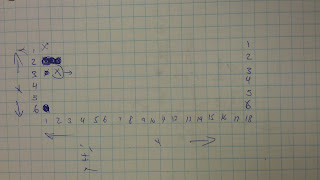
So with the conclusion of this semester, we pretty much have the game more or less where we wanted it to be. To break things down with the design document in summary, ENDLESS (our game's title) is a top down shooter that involves having players survive 'endless' waves of robots that are trying to take over the world.
With the start of our design process we thought of trying to keep things simple as we had decided to start completely from scratch since the game we tried to piece together in the first semester didn't work out too well for the result. This time around, we thought that without too many limitations to what we could do with designing a new game for the semester, the idea of a top down shooter seemed to fit the description the best.
Originally, we had planned out all of the necessary designs within the first month with concepts of what the characters may look like, what the level layout should be, as well as having a paper prototype that would be a miniature guide in terms of where we wanted to go with this and what abilities that the player characters would each be able to perform. This ended up needing a lot of tweeking in the design as to cut down on certain things or change the abilities of each characters. This was mainly done to the engineer class mainly due to being unsure as to whether the original idea of letting them place turrets would be overpowered, or to give them a shield or the ability to control an enemy unit.
So with the paper prototype done, it involved quite a bit of play testing and tweeking as we went along to determine how balanced the game would be. We figured that the players would only be able to move about 3
spaces any which way, so long as it wasn't into a blocked path. Enemies would continually spawn at the end of each player turn at locations on the grid determined by rolling dice. This included colour coded enemies to determine the type of enemy (speed, tank, power, which have their own methods of movement as well as numerical values
associated with HP) that would keep the game entertaining for those playing it. To keep things balanced, die rolls are used to keep it as a game of chance as well as involving some form of strategy depending on the number of players playing at a time. Players will be able to have 1 turn each consisting of movement as well as attacking which can be done in any order in their respective turns. When an enemy dies, the players will
gain points represented as 'kill counts'.
As far as the in game tech side of things go, more or less the game functions the same way except that the AI enemies will target the players and are not limited to the movement they make or too large or a range restriction when the enemy attacks the player. The player is assisted by other characters as well which will aid the playe
r in surviving longer in the game. Although the game doesn't technically end, enemies will get stronger each wave as well as more enemies will spawn. At the result of the ending of the game, the idea is that it provides a sense of
a high score that they achieve through the game to allow for some competitiveness. Strategy still becomes a factor in terms of survival in the game, hence the need to provide limitations such as cooldowns of skill use, certain rates of fire for their weapons and any area of effect skills.
Although there wasn't much testing done with the paper prototype, based off of the demoing of the board game, the idea seemed to hit it off somewhat well in terms for those who were into complex board games, although this
is the case some issues that were noticed was that the medic is the key player in the game. Players who've tried this out did manage to survive longer with keeping the medic player alive, however due t
o the result of the idea that the player will eventually lose, none of the play testers there believed that the paper prototype was overpowered for enemies which came as a surprise. On the digital version of our game, not much testing was done with this either, most people found it interesting aesthetically due to the models for the
environment. Most found the game to be pretty challenging so it's probably something that might need to be a bit more balanced out in terms of ease of play-ability with the difficulty of the game's default being set too high.
With the group Slightly Toasted, these are the following team members who worked with the development of the game throughout the semester:
Curtis Hanna - A 4th year student who is currently taking the game design 2 course who worked with creating a game paper prototype and designing the board game for ENDLESS
Kevin Astilla - 3rd year student who is the team's lead modeler and artist involved in concept art and modeling the player characters
Patrick Kwok - 3rd year student as lead programmer for the team in charge of setting up base coding and game play for use
Victor To - A 3rd year student who worked with being an assistant modeler, animator, minor programmer with getting the characters rigged, the modeling of enemy mobs and network coding for the team
Winson Ng - A 3rd year student who is the team's assistant programmer and modeler working with networking and rigging of the medic character
Tuo Xiao (Stone) - level designer, artist and modeler














